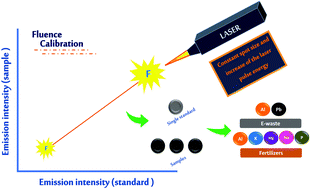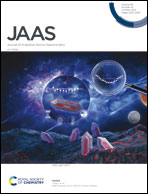A novel strategy for direct elemental determination using laser-induced breakdown spectroscopy: fluence calibration†
Abstract
Quantitative analysis requires a lot of effort to obtain an adequate calibration method to overcome matrix effects employing direct solid analysis by laser-induced breakdown spectroscopy (LIBS). To this end, in this study, a new calibration strategy using different laser fluence values, named Fluence Calibration (FC), was developed and evaluated for LIBS quantitative analysis. In FC-LIBS, only one single calibration standard (a pellet with a known concentration of the analyte) and pellets of the sample are used to build a linear model from the emission signals acquired at different laser fluence values, optimized for each matrix sample used in the method development (printed circuit board – waste PCB and fertilizer samples). Satisfactory trueness was obtained for the determination of Al (94 to 115%) and Pb (98 to 100%) in PCB samples and Al, K, Mg, Na and P (ranging from 81 to 120%) in fertilizer samples, in which one sample of each matrix was used as a standard for calibration. For some fertilizer samples, the plasma normalization process did not occur and the matrix effects were not efficiently overcome using FC-LIBS. Standards for calibration were also prepared from salts and adequate figures of merit (i.e. accuracy and precision) were achieved using FC-LIBS for Al (trueness ranged from 82 to 114% and relative standard deviation – RSD 14%) in PCB samples and for Al and P (trueness ranged from 82 to 114% and RSD from 11 to 31%) in fertilizer samples. The FC-LIBS method is an alternative among the nontraditional methods of calibration that allows faster and simpler pellet preparation compared to traditional univariate calibration strategies, acquisition and data treatment for the direct analysis of complex solid samples.



 Please wait while we load your content...
Please wait while we load your content...